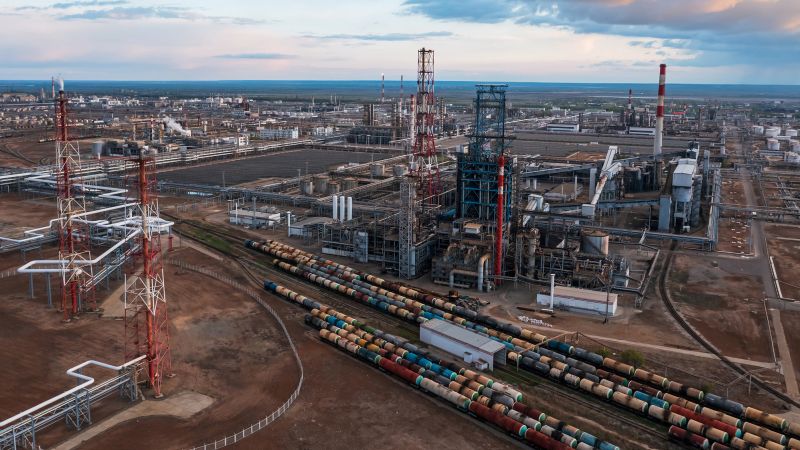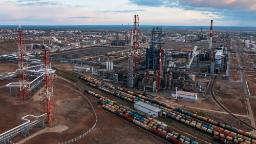

London
CNN Business
—
Most Russian crude oil exports to Europe are now banned, marking the boldest effort yet by the West to pile financial pressure on President Vladimir Putin as his brutal war in Ukraine enters its tenth month.
The oil embargo, which was agreed upon in late May, took effect in the European Union on Monday. It was accompanied by a new price cap on Russian crude set by G7 countries. That’s designed to limit the Kremlin’s revenues while allowing countries such as China and India to continue to buy Russian oil, provided they don’t pay more than $60 a barrel.
What happens next will likely hinge on the response from Moscow, which has vowed not to cooperate with the price cap and could slash its production, rattling global energy markets. Global crude prices were up 2.6% on Monday as investors watched nervously for the next move.
Here’s what you need to know about the oil embargo, the price cap and the potential impact.
The European Union now prohibits Russian crude oil imports by sea, setting up the bloc to have phased out 90% of oil imports from Russia. It’s a huge move given that Europe received roughly a third of its oil imports from Russia in 2021. More than half of Russia’s exports went to Europe 12 months ago.
There are a few exceptions. Bulgaria received a temporary carve-out. The embargo also doesn’t target imports via pipeline. That means the Druzhba pipeline can continue to supply Hungary, Slovakia and the Czech Republic. (Germany and Poland are working to end pipeline imports from Russia as soon as possible.)
But the embargo is significant. In 2021, the EU imported €48 billion ($50.7 billion) worth of crude oil and €23 billion ($24.3 billion) of refined oil products from Russia. Two-thirds of those imports arrived by sea.
A ban on Russian refined oil products, such as diesel fuel, imported by sea will launch in early February.
The European Union, plus the other members of the G7 — the United States, Canada, Japan and the United Kingdom — and Australia also agreed on Friday to cap the price of Russian crude oil at $60 a barrel, a policy aimed at Moscow’s other customers. This measure took effect Monday, too.
The price cap, which can be adjusted over time, is designed to be enforced by companies that provide shipping, insurance and other services for Russian oil. If a buyer pays more than the cap, they would withhold their services, in theory preventing the oil from being shipped. Most of these firms are based in Europe or the United Kingdom.
Despite unprecedented sanctions from the West, Russia’s economy and the government’s coffers have been padded by its lucrative position as the world’s second largest exporter of crude oil behind Saudi Arabia.
In October, Russia exported 7.7 million barrels of oil per day, just 400,000 barrels below pre-war levels, according to the International Energy Agency. Revenues from crude oil and refined products currently stand at $560 million per day.
By quickly phasing out imports, Europe hopes to limit inflows to Putin’s war chest, making it harder for him to continue his war in Ukraine.
But countries like China and India have stepped in buy surplus barrels. That’s where the price cap comes in.
G7 countries don’t want Russian oil taken off the market entirely, since that would push up global prices at a time when high inflation is hurting their economies. By enacting a price cap, they hope that can keep barrels flowing, but make the business less profitable for Moscow.
That’s far from certain. Countries like Poland and Estonia wanted a lower price cap, emphasizing that $60 is too close to the current market price for Russian oil. At the end of September, Russian Urals crude was trading just under $64 a barrel.
“Today’s oil price cap agreement is a step in right direction, but this is not enough,” Estonian foreign minister Urmas Reinsalu tweeted Friday. “Why are we still willing to finance Russia’s war machine?”
Enforcement could also prove difficult. Russia and its customers could start using more ships and insurance providers outside Europe and the United Kingdom to circumvent the rules, increasingly relying on what’s termed a “shadow fleet.”
“Capacity in that fleet has been growing, and it could probably handle Russian volumes for a while,” said Richard Bronze, head of geopolitics at Energy Aspects, a research firm.
Kremlin spokesperson Dmitry Peskov said Monday that Moscow will “not recognize any price caps.” Russian Deputy Prime Minister Alexander Novak said Sunday that Russia would not export oil to countries adhering to the cap, even if that will mean cutting production.
Oil prices have fallen sharply since the spring as fears about a global recession that may hit demand have come to the fore. Now, all eyes are on Russia’s response. Peskov said the price cap was a step towards “destabilizing the world energy markets.”
Moscow needs to find replacement customers for 1.1 million barrels per day of crude that had still been flowing to Europe, according to the IEA. That may not be easy, especially as coronavirus restrictions and a growth slowdown in China affect demand from the world’s second biggest economy.
The price cap adds to the uncertainty. Would-be customers may decide buying Russian cargoes has become too risky and complex, taking another batch of buyers off the market.
As the Kremlin has threatened, Russia may reduce its oil output as a result. The IEA has estimated Russia will slash output by an additional 1.4 million barrels per day by early 2023.
Other factors will dictate prices, too. Rare protests in China have raised questions about the country’s commitment to its “zero-Covid” policy, and demand could increase if its economy picks up pace.
The Organization of the Petroleum Exporting Countries, or OPEC, could also alter its output. The cartel on Sunday decided to stick with previously announced production cuts, giving it more time to assess the effects of the embargo and the price cap.
Europe’s embargo on refined oil products in February could also be a flash point for energy prices, since the region remains dependent on Russian diesel. Finding alternative sources in just two months may be tricky.
— Anna Chernova contributed reporting.
